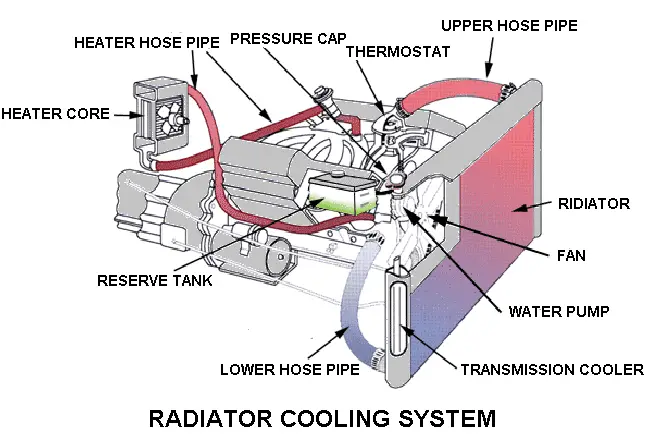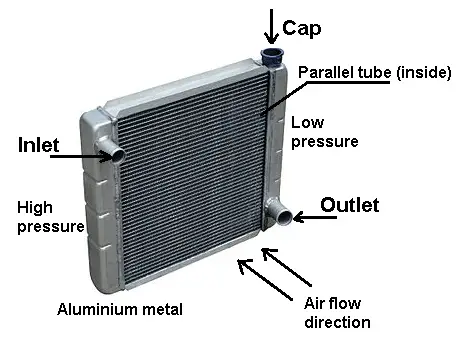Today we’ll discuss the cooling system of your vehicle and how it works, the cooling system in your vehicle consists of the Water pump, Radiator, Cooling fans as well as Thermostat.
In this article, we’ll discuss radiator types and working.
What is a Radiator?
The radiators are heat exchangers used to transfer thermal energy from one medium to another for cooling and heating.
A radiator is a device consisting of a large amount of cooling surface that contains large amounts of air so that it spreads through the water to cool efficiently.
The radiator has a wide range of applications in automobile industries there are mainly used to cool the internal combustion engine in the automobile.
They are also used in piston-engined aircraft, railways, locomotives, motorcycles, stationary generating plants, and other places where such engines are used.
Radiators are classified according to the direction of the water flow through them. In some, the water flows from top to bottom-down flow type radiator. In other, the water flows horizontally from an input tank on one side to another tank on the other side-cross flow type radiator.
Radiators are usually made of copper and brass because of their high heat conductivity. The various sections of the radiators are almost completely joined by soldering.
Read Also: Different Types of Car Sensors and their Functions
Types of Radiator
There are two basic types of radiator
- Tubular type
- Cellular type
Tubular Type Core
In the tubular-type core, the upper and lower tanks are connected by a series of tubes through which water passes. Fins are placed around the tubes to improve heat transfer. Air passes around the outside of the tubes, between the fins, absorbing heat from the water in passing.
In a tubular radiator, because the water passes through all the tubes, if one tube becomes clogged, the cooling effect of the entire tube is lost. In a cellular. radiator, the clogging of any passage results in a loss but of a small part of the total cooling surface.
Cellular Type Core
In the cellular-type core, air passes through the tubes and the water flows in the spaces between them.
The core is composed of a large number of individual air cells which are surrounded by water. Because of its appearance, the cellular type usually is known as a honeycomb radiator, especially when the cells in front are hexagonal.
In a cellular. radiator, the clogging of any passage results in a loss but of a small part of the total cooling surface.
Read also: Types of Cooling System In Engine.
Construction of Radiator
It consists of an upper tank and a lower tank and between them a core.

- The upper tank is connected to the water outlet or outlets from the engine jacket by a hose pipe, and
- The lower tank is connected to the jacket inlet through the water pump.
- The core is a radiating element, which cools the water.
Radiator Working Principle
Radiator working principle:
The radiator is a pretty simple device. Nowadays most modern cars use aluminium radiators. Radiators usually have a tank on each side, and inside the tank is a transmission cooler.

In this type of radiator, you’re going to have an aluminium mesh. In this aluminium device, It consists of two ports inlet an outlet. Inside the radiator, some tubes are mounted in a parallel arrangement. And the aluminium fins are attached to all of the tubes.
The radiator work is very simple. In the radiator, the coolant flows from the inlet to the outlet through many tubes mounted in a parallel arrangement.
The hot water enters the radiator through the inlet port. A fan is attached behind the radiator to cool down the hot water in the tubes. The fan blows the air and cools down the water. So the water is going to come out cooler than it entered before and then go back to the engine.
Now how it does that air is going to be feeding through this.
The aluminium fins are attached to the tubes this is called a tabulator. Now the tubes are filled with hot coolant coming from the engine. So they’re going to give off heat to this aluminium coat by passing air through the fan, it cools the aluminium coat.
If the fluid flowed very smoothly through the tubes, only the fluid touching the tubes would be cooled directly. Now it is going to send out to the cooler and then go back to the engine.
Cooling System In Engine
Here’s how it’s set up in your car first you have a radiator in the front side of the car. Next, there is an engine, a water pump, and a thermostat.
So what happens is when you start your car the coolant starts running through the engine. As the engine warms up the coolant starts getting heat and the coolant hot coolant sends it to the radiator to cool down. After cooling down, the coolant goes back into the engine.
Fan
The fan is mounted behind the radiator on the water pump shaft. When the engine is running at a low speed it is certainly insufficient to produce the desired cooling from nature. Here the fan serves the purpose.
Thermostat
Now what the thermostat does is as you’ve got coolant running through the engine it looks at the temperature of it. Once the temperature gets too high and your engine is warmed up. Then the thermostat detects and passes the coolant back through the radiator and then the coolant will come cool through the radiator.
Water Pump
The water pump is used to increase the velocity of the circulating water. When a low-temperature coolant passes through the water pump it pumps the coolant back into the engine.
Can You Drive a Car Without a Radiator?
Yes, you can start your car without a radiator but it is risky. You will not cause any damage as long as the engine does not overheat. If you don’t run it long enough for the engine to get too hot, it’s not an issue. If your car gets overheated you have to shut down the car and let it cool off via convection.
Theoretically, radiators are completely optional on the engine. Air-cooled engines have existed for a very long time. These radiators have cooling fins to extract the heat and release it into the air.
But,
However if your car was designed to require a radiator, you need one. There is no benefit of removing it.
Causes an Engine To Overheat?
The insufficient quantity of water causes overheating in the cooling system. It is also caused by the clogged radiator and water passages, slipping from the belt, imperative thermostat, late ignition timing, incorrect valve timing, pre-ignition, too tight bearing, too low engine oil level, clogged exhaust system, etc.
What Is The Sign of A Bad Radiator?
- Warmness will occur when the coolant cannot get where it needs to go to cool the engine.
- The hoses could be clogged, or the level of coolant is too low.
- There may be a warning light on the dashboard, or the temperature gauge will show too hot.
- If there is a broken hose, or the radiator is corroded with rust, you may notice the smell of antifreeze or a tell-tale puddle on the garage floor
- If your smoke is coming from under the hood, the coolant may have leaked onto the motor and it is being burnt off.
- However, if you see smoke coming from the muffler, it could mean that the head gasket has been damaged from the engine’s warmness.
Download PDF of this article
If you like our article on “radiator and types of radiator” let me know in the comment section below. If you like our article then please share with your friends on Facebook.
Read Next:

Could I have the pdf file, please.
The PDF file has been sent to your inbox.
Could you please send pdf for me
The PDF file has been sent to your inbox.
Always good material for beginners. Would you mind to send me the pdf file.
Thanks for your feedback. The PDF file has been sent to your inbox.
Can I have the pdf,please.
The PDF file has been sent to your inbox.
This is so helpful. Can I have it on my inbox
I’m glad it was helpful for you. I just sent you the PDF file to your inbox.
Sir,thank you so much this topics about radiator.being a beginners it is a big opportunity for me to learn more.
I’m glad it was helpful for you. You’re welcome and keep visiting.
Nice explanation sir.
Thanks for reading.